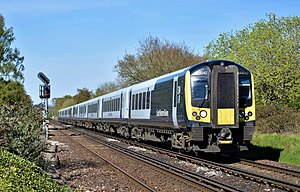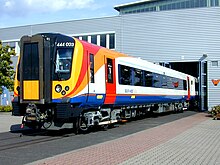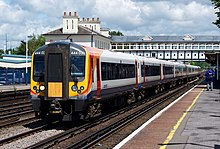British Rail Class 444
| British Rail Class 444 Desiro | |
|---|---|
 A pair of South Western Railway Class 444s near Southampton Airport Parkway in 2021 | |
 Refurbished standard-class saloon | |
| In service | 21 April 2004 – present |
| Manufacturer | Siemens Transportation Systems |
| Assembly | Siemens SGP Verkehrstechnik[1] |
| Built at | Vienna, Austria |
| Family name | Desiro |
| Replaced | |
| Constructed | 2002–2004[2] |
| Refurbished | 2017–2020[3] |
| Number built | 45[4] |
| Formation |
|
| Fleet numbers | 444001–444045 |
| Capacity | |
| Owners | Angel Trains[6] |
| Operators | South Western Railway |
| Depots | Northam[4] |
| Specifications | |
| Car body construction | Aluminium |
| Train length | approx. 119 m (390 ft 5 in)[5] |
| Car length | 23.57 m (77 ft 4 in)[6] |
| Width | 2.796 m (9 ft 2.1 in)[7] |
| Floor height | 1.157 m (3 ft 9.6 in)[7] |
| Doors | Single-leaf sliding plug (2 per side per car) |
| Wheel diameter | 850–786 mm (33.46–30.94 in) (new–worn)[7] |
| Wheelbase | Bogies: 2.600 m (8 ft 6.4 in)[8] |
| Maximum speed | 100 mph (160 km/h)[4] |
| Weight |
|
| Traction system | Siemens SIBAS IGBT[7] |
| Traction motors | 8 × Siemens 1TB2016-0GB02 asynchronous three-phase AC[6] |
| Power output | 1,500 kW (2,000 hp) (at wheel)[7] |
| Tractive effort | Starting: 200 kN (45,000 lbf)[5] |
| Acceleration | approx. 1 m/s2 (3.3 ft/s2)[7] |
| Electric system(s) | 750 V DC third rail |
| Current collector(s) | Contact shoe |
| UIC classification | Bo′Bo′+2′2′+2′2′+2′2′+Bo′Bo′[7] |
| Bogies | Siemens SGP SF5000[7] |
| Minimum turning radius | 120 m (393 ft 8 in)[8] |
| Braking system(s) | Electro-pneumatic (disc) and regenerative |
| Safety system(s) | |
| Coupling system | Dellner 12[9] |
| Multiple working | Within class, and with Class 450[2] |
| Track gauge | 1,435 mm (4 ft 8+1⁄2 in) standard gauge |
The British Rail Class 444 Desiro is an electric multiple-unit passenger train built by Siemens Transportation Systems in Austria between 2002 and 2004. The Class 444 currently operate on express passenger services for South Western Railway.
The class first entered service with South West Trains in 2004.
Description

At the start of the 21st century, as part of its franchise agreement, South West Trains was required to replace the slam-door rolling stock of Classes 411, 412, 421 and 423, which did not meet modern health and safety standards, with new trains by 2005.[10] In April 2001 an order was placed with Siemens for 785 vehicles. This was originally to be split as 100 four-car Class 450/0 outer-suburban units, 32 five-car Class 450/2 inner-suburban units, and 45 five-car Class 444 express units.
The Class 444 fleet was built at Siemens' Vienna plant.[10][11] Before being shipped to Britain via the Channel Tunnel, the trains were extensively tested at Siemens' Wegberg-Wildenrath Test and Validation Centre in Germany.[10] This was an attempt to reduce the time taken for new trains to enter service, by ironing out any problems beforehand. Many other designs of new train, such as the Alstom-built Class 458 units, had been plagued by problems and poor reliability. The Desiro fleet entered service faster than its competitors, but still suffered teething problems.
Each unit is formed of five cars; a driving motor car at each end and three intermediate trailers. One trailer in each unit is provided with two wheelchair spaces and a universally-accessible toilet. The units have end-gangways, allowing passengers to move between units when used in multiple. Trains are limited to a ten-car length (i.e. two units), as longer trains cannot be accommodated in stations. At some stations with particularly short platforms (for example Shawford, in Hampshire), even a single unit of five cars is too long for the platform. Passengers used to have to board and alight via a single door opened by the guard, however, since the introduction of automatic selective door operation (ASDO) in early 2015, the computer system works out how many cars to release the doors on.
The fleet was originally painted in a mixture of SWT's express livery of white, with a blue window band, and red/orange swishes at the cab ends (although they replaced the South West Trains logo with a South Western Railway one, following their inheritance of the franchise), although all units have since received the new South Western Railway livery, which is predominantly light grey with darker grey sections towards the cabs, and doors painted in the opposing shade of grey to the bodywork in that area.
Each five-car unit has a first-class section taking up just over half of one car at one end. All seats have BS 1363 230 V mains sockets providing AC power for laptops or mobile phone chargers.
Like all new-build third-rail rolling stock in the UK, one car in each unit is fitted with a recess for a pantograph that allows for a future conversion to AC overhead power.
Both the Class 444 and 450 fleets are maintained at the purpose-built Northam Traincare Facility in Southampton, which is equipped to perform both preventative and corrective maintenance, deep-cleaning, and overhauls on up to eight units simultaneously.[12]
In March 2012, the Class 444, 450 and 458 fleets were fitted with regenerative braking.[13]
A new variable-stiffness hydraulic bush has been fitted to the whole Class 444 fleet so as to reduce track damage and thus infrastructure maintenance costs. This work was completed by the end of 2013.[14]
Awards
Class 444 trains have been awarded the "Golden Spanner 2010" as Britain's most reliable trains by Modern Railways. During twelve months, SWT's fleet has set a new reliability record of almost 89,000 kilometres per technical delay.[15]
Operations


The first Class 444 units entered service with SWT in early 2004. As part of the launch, unit no. 444018 was named The Fab 444 at a ceremony at London Waterloo.
The units were introduced on services from London Waterloo to Portsmouth Harbour via the Portsmouth Direct Line. They were also used on some services on the South West Main Line to Southampton Central, Bournemouth, Weymouth and on limited outer suburban services to Alton and Basingstoke. This allowed the withdrawal of the final 411 units by mid-2004, and inroads were made to the 421 and 423 fleets.
It was originally hoped that the final slam-door trains would be withdrawn by the end of 2004. In the event, some were allowed to remain operational until May 2005, as the last replacement Desiros came into service. Initially, the Class 444s were used mainly on Portsmouth direct services, allowing the Class 442 units to be used on the Weymouth line. The Class 444 units were also used regularly on Sunday-only Bournemouth stopping services, Waterloo to Southampton services and the Brockenhurst to Wareham shuttle service. Previous power limitations meant that the trains were not permitted to run west of Poole; these restrictions have since been lifted.
During 2007, the Class 444 units replaced the Class 442 on the Weymouth line. Some Class 442 workings were taken over by Class 444 units as early as November 2006; the final Class 442 was withdrawn in February 2007. Class 444 units transferred to the Weymouth line were replaced on Portsmouth services by Class 450 Desiros which became available after the reintroduction of the Class 458 units on the Waterloo to Reading line. The decision to transfer many Class 444 units to the Weymouth line was not popular. Portsmouth line passengers protested over the use of Class 450 on some services,[16] while there were complaints that the Class 444 were inferior to the units they replaced on the Weymouth line.[17]
Class 444s are currently used on the following services:
- Waterloo to Basingstoke (peak services)
- Waterloo to Portsmouth Harbour via Guildford (shared with Class 450)
- Waterloo to Portsmouth Harbour via Basingstoke and Fareham (shared with Class 450)
- Waterloo to Weymouth / Poole
Refresh
South Western Railway has conducted a refurbishment programme under its contract from 2017 onwards. As part of this work, every unit has been deep cleaned, and the carpets and seat covers in standard class replaced. In addition, plug sockets have been provided at every pair of seats, and the guard's office and buffet unit have been removed to provide extra seats. First class has been reduced from 35 seats to 32, and the 2+1 seating has been replaced with 2+2 seating, with leather seats and new tables providing facilities for wireless charging.[18]
Fleet details
| Class | Operator | Qty. | Year built | Cars per unit | Unit nos. |
|---|---|---|---|---|---|
| 444 | South Western Railway | 45 | 2002–2004 | 5 | 444001–444045 |
Interiors
- Original standard-class interior in 2012
- Original first-class interior in 2015
- Refurbished first-class interior in 2021
Illustration
Named units
The following units have received names:
- 444001: Naomi House (de-named)[19]
- 444012: Destination Weymouth[20]
- 444018: FAB444[20]
- 444023: The Alex Wardle Foundation[21]
- 444040: The D-Day Story Portsmouth 80 Anniversary[22]
Special Liveries
In 2019, 444019 was painted in a Pride livery to celebrate diversity in the company and its customers. It has rainbow flags at both cab ends, on both sides. [23]
References
- ^ Background information: Siemens plant at Simmering in Vienna (PDF). München: Siemens AG. 23 February 2016. p. 4. Archived (PDF) from the original on 27 February 2021. Retrieved 13 January 2023.
- ^ a b c "Our Trains - Class 444 'Desiro'". South Western Railway. London: First MTR South Western Trains. Archived from the original on 20 January 2022. Retrieved 13 January 2022.
- ^ Holden, Michael (9 January 2020). "South Western Railway completes £70m refurbishment of Class 444s". RailAdvent. Retrieved 13 January 2023.
- ^ a b c d Trains - Reference List (PDF). Erlangen: Siemens Transportation Systems. 8 September 2006. p. 38. Archived from the original (PDF) on 6 October 2011. Retrieved 13 January 2023.
- ^ a b c d Technical Information: Class 444 (PDF). London: Siemens Transportation Systems. April 2003. Archived from the original (PDF) on 7 November 2007. Retrieved 13 January 2023.
- ^ a b c "Our Fleet - Class 444". London: Angel Trains. Archived from the original on 4 September 2021. Retrieved 29 December 2021.
- ^ a b c d e f g h Technical Information: Desiro UK Electrical Multiple Unit Family. Erlangen: Siemens Transportation Systems. 2005. Order No. A19100-V800-B251-V2-7600.
- ^ a b First Class Bogies (PDF) (08/08 ed.). Graz: Siemens Transportation Systems. pp. 60–61, 67. Archived from the original (PDF) on 27 June 2013. Retrieved 11 January 2023.
- ^ System Data for Mechanical and Electrical Coupling of Rail Vehicles in support of GM/RT2190 (PDF). London: Rail Safety and Standards Board. 22 June 2011. p. 4. SD001. Archived from the original (PDF) on 1 April 2012. Retrieved 22 November 2022.
- ^ a b c "Class 444". Southern E-Group. Retrieved 19 July 2011.
- ^ "Desiro: Technical Data". Modern Locomotives Illustrated. No. 178. August 2009. pp. 13–15.
- ^ "Class 450 and Class 444 - South West Trains". Siemens Mobility. Archived from the original on 28 June 2017. Retrieved 11 January 2023.
- ^ "Green braking for South West Trains". Rail Technology Magazine.
- ^ "Desiro bushes giving a smoother ride". Rail Magazine. Peterborough. 10 August 2011. p. 9.
- ^ "Siemens Desiro Class 444 wins award as most reliable train". Transport Weekly. 12 January 2011. Retrieved 15 January 2011.
- ^ "Commuter protest over rail seats". BBC News. 22 January 2007. Retrieved 10 May 2008.
- ^ Jolliffe, Bob (21 January 2007). "Councillor sceptical at train service changes". Bournemouth Daily Echo. Retrieved 11 March 2012.
- ^ "SWR Refurbishment". South Western Railway. Archived from the original on 30 November 2018. Retrieved 29 November 2018.
- ^ Bendall, Simon; Coward, Andy (July 2023). "Naming Update". Fleet Review. Railways Illustrated. No. 245. Horncastle: Mortons Media Group. p. 23. ISSN 1479-2230.
- ^ a b "Desiro: Fleet Listing". Modern Locomotives Illustrated. No. 178. August 2009. pp. 72–76.
- ^ Butlin, Ashley (April 2023). "Multiple Units". Stock Update. The Railway Magazine. No. 1465. p. 88.
- ^ Bendall, Simon; Coward, Andy (August 2024). "Naming Update". News. Railways Illustrated. No. 258. p. 20.
- ^ "SWR launches UKs first Intersex Inclusive Pride train". Southwestern Railway.
External links
- Class 444 "Desiro" - South Western Railway




